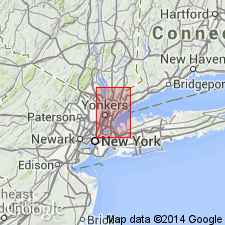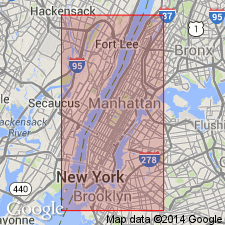
- Usage in publication:
-
- Pelham Bay Member*
- Modifications:
-
- Named
- Dominant lithology:
-
- Amphibolite
- Gneiss
- Schist
- AAPG geologic province:
-
- New England province
Summary:
Interbedded amphibolites, gneisses, and schists of very high metamorphic grade, granulite, and pegmatite, are here named the Pelham Bay Member of the Hartland Formation of the Hutchinson Bay Group. It is exposed in the Long Island Sound area of New York, but may extend beneath the sound off the Connecticut coast. Thickness is 1,500 m maximum. Age is probably Late Cambrian to Early Ordovician, based on a K-Ar age of 380 Ma.
Source: GNU records (USGS DDS-6; Reston GNULEX).

- Usage in publication:
-
- Pelham Bay Member*
- Modifications:
-
- Age modified
- AAPG geologic province:
-
- New England province
Summary:
In NY City, Cameron's Line, a tectonic boundary which shows evidence of extreme compression and thrust faulting, separates the Manhattan Prong with its Middle Proterozoic Fordham Gneiss overlain by Cambrian and Ordovician allochthonous units on the west, from the allochthonous eugeoclinal Hartland Formation and Ravenswood Granodiorite on the east. The Hartland is mapped in the east Bronx and Queens; the Ravenswood in is Queens, Kings, and lower east Manhattan. All 3 of these were previously mapped as Brooklyn Gneiss or Brooklyn Injection Gneiss which should be abandoned. The age of the Hartland and Ravenswood is Cambrian and Ordovician, based on correlation with rocks of southwestern CT, their relative positions and lithologic similarities. Isotope data on the Ravenswood gives an early Paleozoic age, probably Early Ordovician.
Source: GNU records (USGS DDS-6; Reston GNULEX).

- Usage in publication:
-
- Pelham Bay Member*
- Modifications:
-
- Age modified
- AAPG geologic province:
-
- New England province
Summary:
In the New York City area, the allochthonous Hartland Formation and its Pelham Bay Member and related Ravenswood Granodiorite, east of Cameron's Line, overlie Manhattan Schist Member C of Early and Middle Cambrian age. The age of the Hartland, Pelham Bay, and Ravenswood ranges from Middle Cambrian to Middle Ordovician (fig. 2).
Source: GNU records (USGS DDS-6; Reston GNULEX).
For more information, please contact Nancy Stamm, Geologic Names Committee Secretary.
Asterisk (*) indicates published by U.S. Geological Survey authors.
"No current usage" (†) implies that a name has been abandoned or has fallen into disuse. Former usage and, if known, replacement name given in parentheses ( ).
Slash (/) indicates name conflicts with nomenclatural guidelines (CSN, 1933; ACSN, 1961, 1970; NACSN, 1983, 2005, 2021). May be explained within brackets ([ ]).

